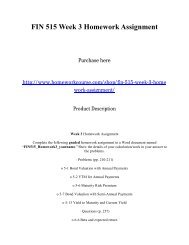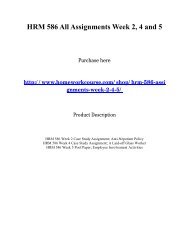HRM 595 Full Course Project
You also want an ePaper? Increase the reach of your titles
YUMPU automatically turns print PDFs into web optimized ePapers that Google loves.
<strong>HRM</strong> <strong>595</strong> <strong>Full</strong> <strong>Course</strong> <strong>Project</strong><br />
Purchase here<br />
http://www.homeworkcourse.com/shop/hrm-<strong>595</strong>-full-course-p<br />
roject/<br />
Product Description<br />
<strong>Course</strong> <strong>Project</strong>: Negotiation Analysis Paper<br />
Objective<br />
The purpose of the negotiation analysis paper is to help you transfer the negotiation concepts from<br />
the course to negotiations in your own organization. I would like you to use concepts learned in the<br />
course to analyze a negotiation situation. The negotiation may be one that has recently concluded<br />
or one that you are in the midst of. It may be a negotiation between organizations or within an<br />
organization. It may be a dyadic negotiation or one with multiple parties. It may be a situation of<br />
chronic conflict. It also may be a negotiation in which you observed and are familiar with the<br />
parties to the negotiations in order to conduct an analysis.<br />
Guidelines<br />
Paper (due in Week 7) must conform to APA format and be 13–15 pages in length, not including<br />
the title page, abstract and references. Spend no more than three pages describing the situation.
Negotiation should be complex enough to challenge your analytic skills. Topic proposal due in<br />
Week 3 (one page).<br />
Milestones:<br />
Week 3 - The proposed topic for the project paper is due in Week 3 (20 points). The proposal<br />
should be an explanation of the chosen negotiation topic, the parties to the negotiation, and<br />
proposed areas of analysis including negotiation strategies and tactics used. The proposal should<br />
be one page. Week 7 - Final completed paper is due (130 points)<br />
Grading Rubrics<br />
HR<strong>595</strong> NEGOTIATION SKILLS TERM PAPER<br />
Total Points - 130<br />
Criteria for Evaluating Written Assignments<br />
Meets Expectations<br />
Partially Meets Expectations<br />
Fails to Meet Expectations<br />
Points Earned<br />
Intellectual Understanding<br />
(20 Points)<br />
Addresses all aspects of assignment in sufficient depth<br />
Addresses most aspects of assignment in sufficient depth<br />
Does not address most aspects of assignment and/or fails to do so in sufficient depth<br />
Creativity<br />
(20 Points)<br />
Analyzes and discusses many negotiation concepts by extending and elaborating with realistic<br />
examples<br />
Discusses with some analysis several negotiation concepts by extending and elaborating with<br />
realistic examples
Does not discuss negotiation concepts or apply them to realistic examples<br />
Insight<br />
(20 Points)<br />
Exhibits a substantive and perceptive ability in analyzing and discussion negotiation topic that is<br />
the focus of the paper<br />
Discusses assignment topic with some substance and evidence of perceptive ability<br />
Does not exhibit perceptive ability in discussing the assignment topic<br />
Validity<br />
(20 Points)<br />
The majority of opinions and analyses are rigorously supported by appropriate research.<br />
Some opinions are supported by appropriate research but much is not supported<br />
The majority of opinions and analysis is not supported by appropriate research<br />
Intellectual Honesty<br />
(20 Points)<br />
All references are acknowledged and properly cited in APA format<br />
Some references are acknowledged and properly cited in APA format<br />
References are not properly acknowledged and cited and/or do not conform to APA format<br />
Organization and Style<br />
(30 Points)<br />
Introduction - Central theme/purpose is clearly identifiable and well developed; introductory<br />
comments provide sufficient background on the topic and preview major points<br />
Introduction – Either the central theme/purpose is clearly identifiable and well developed; or the<br />
introductory comments provide sufficient background on the topic and preview major points, but<br />
not both<br />
Introduction - Central theme/purpose is not clearly identifiable nor well developed; introductory<br />
comments do not provide sufficient background on the topic nor preview major points
Conclusion and recommendations follow logically from the body of the paper and bring closure to<br />
the paper<br />
Conclusion and recommendations follow logically from the body of the paper but rather than<br />
bringing closure to the paper, it merely summarizes what has been previously stated<br />
Conclusion and recommendations do not follow logically from the body of the paper nor do they<br />
bring closure to the paper<br />
Subsequent sections develop/support the central theme of the paper<br />
The majority of the subsequent sections develop/support the central theme of the paper<br />
Subsequent sections do not develop/support the central theme of the paper<br />
Structure is clear, logical, and easy to follow; smooth transition between paragraphs which help<br />
maintain the flow of thought<br />
Usually the structure is clear, logical, and easy to follow, with smooth transitions between<br />
paragraphs to help maintain the flow of thought<br />
Sometimes the structure is clear, logical, and easy to follow; seldom includes smooth transitions<br />
between paragraphs to help maintain the flow of thought<br />
Meets minimum assigned length<br />
Does not meet minimum assigned length<br />
No major errors in spelling, punctuation, and grammar<br />
Few errors in spelling, punctuation, and grammar<br />
Numerous errors in spelling, punctuation, and grammar<br />
Paper is laid out effectively - uses headings and other reader-friendly tools<br />
Paper is laid out effectively, but could make better use of headings and other reader-friendly tools<br />
Paper is not laid out effectively; fails to use headings and other reader-friendly tools<br />
Paper is professional in appearance and demonstrates attention to detail; tone of voice is<br />
appropriate to the audience, content, and assignment<br />
Paper is professional in appearance and demonstrates attention to detail; but tone of voice is<br />
inappropriate to the audience, content, and assignment
Paper is not professional in appearance and demonstrates a lack of attention to detail; tone of voice<br />
is inappropriate to the audience, content, and assignment<br />
Best Practices<br />
The following are the best practices in preparing this paper:<br />
Title Page - Include who you prepared the paper for, who prepared, and date. Table of Contents -<br />
List the main ideas and section of your paper and the pages in which they are located. The<br />
illustrations should be included separately. Introduction - Use a header on your paper. This will<br />
indicate you are introducing your paper.<br />
The purpose of an introduction or opening:<br />
1. Introduce the subject and why the subject is important.<br />
2. Preview the main ideas and the order in which they will be covered.<br />
3. Establish a tone of the document.<br />
Include in the introduction a reason for the audience to read the paper. Also, include an overview<br />
of what you are going to cover in your paper and the importance of the material. (This should<br />
include or introduce the questions you are asked to answer on each assignment.)<br />
Body of Your Report - Use a header titled with the name of your project. Example: "The<br />
negotiation between Company X and Company Y; An Analysis". Then proceed to break out the<br />
main ideas. State the main ideas, state major points in each idea, and provide evidence. Break out<br />
each main idea you will use in the body of your paper. Show some type of division, such as<br />
separate sections that are labeled, separate groups of paragraphs, or headers. You would include<br />
the information you found during your research and investigation. Summary and Conclusion -<br />
Summarizing is similar to paraphrasing but presents the gist of the material in fewer words than the<br />
original. An effective summary identifies the main ideas and major support points from the body<br />
of your report. Minor details are left out. Summarize the benefits of the ideas and how they affect<br />
the tourism industry. References - Follow APA Publications Manual, 6th edition in using in-text<br />
citations and include a reference page.<br />
Additional hints on preparing the best possible project:<br />
4. Apply a three step process of writing (plan, write, and complete).<br />
5. Prepare an outline of your research paper before you go forward.<br />
6. Complete a first draft and then go back to edit, evaluate, and make any changes required.<br />
7. Use visual communication to further clarify and support the written part of your report. You<br />
could use example like graphs, diagrams, photographs, flowcharts, maps, drawings, animation,<br />
video clips, pictograms, tables, and Gantt charts if applicable.






